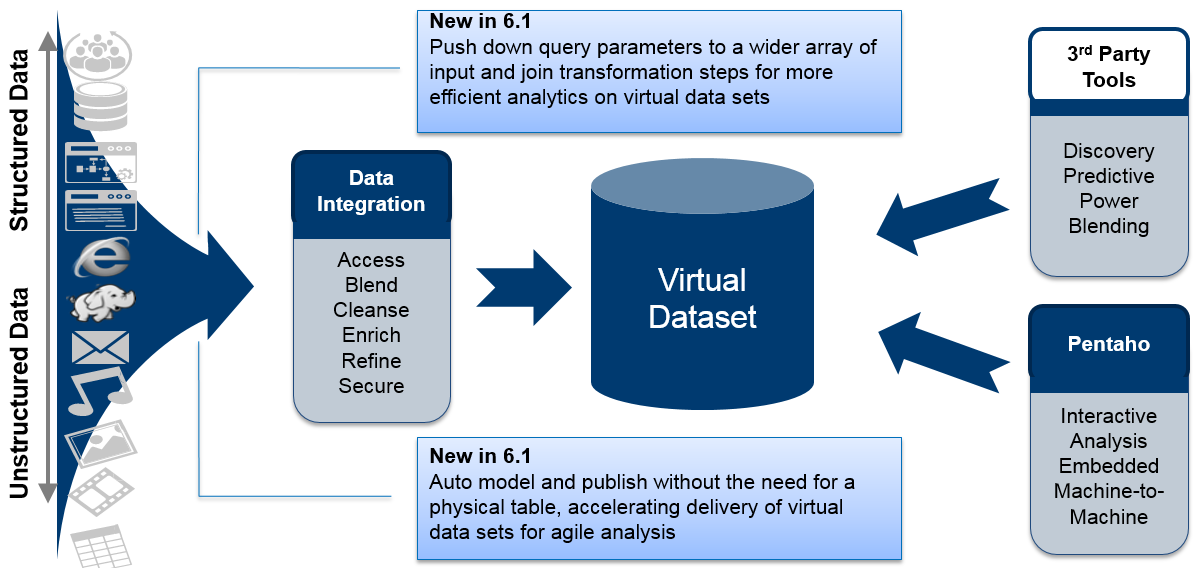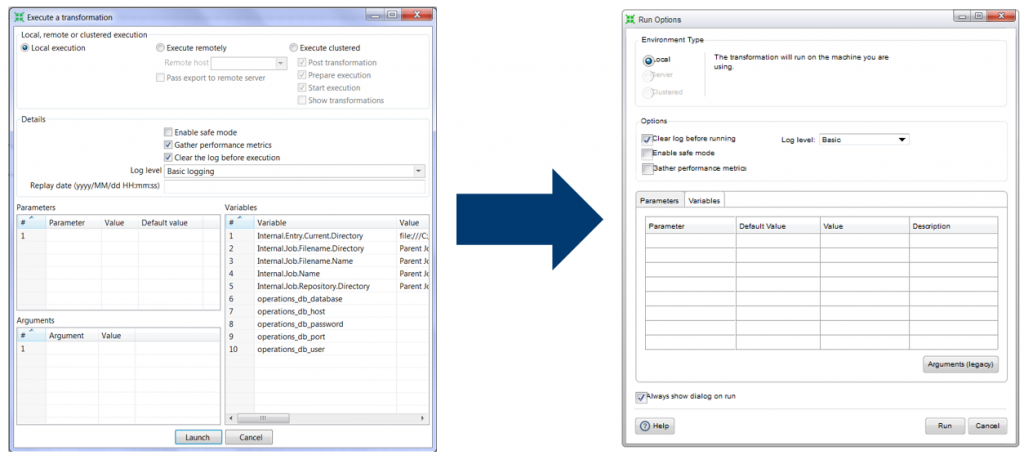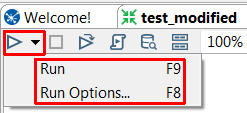I am very excited to share that today we announced Pentaho 6.1 (see also the German press release). There is so much to share that I am dividing this into two blog posts. Today I will share a summary of the new features and improvements of Pentaho 6.1. Stay tuned for tomorrow when I will go into detail about my personal favorite new feature in this release – Metadata Injection.
New Features and Improvements in Pentaho 6.1
Pentaho Data Services
This powerful feature has been around since PDI 5.4 (known as Thin Kettle JDBC driver) and it solves a couple of really nice use cases that the following picture illustrates:
What we did in 6.0: Within 6.0, the usability and performance have been improved by Caching and Push-Down-Optimization. We are not finished, yet: There are remaining use cases to continue these improvements and harden this feature for enterprise use.
And we worked on these in 6.1:
- Added Parameter Pushdown Optimization for Data Services – You can improve the performance of your Pentaho data service through the new Parameter Pushdown optimization technique. This technique is helpful if your transformation contains any step that should be optimized, including input steps like REST where a parameter in the URL could limit the results returned by a web service.
- Driver Download for Data Services in Pentaho Data Integration – When connecting to a Pentaho Data Service from a non-Pentaho tool, you previously needed to manually download a Pentaho Data Service driver and install it. Now in 6.1, you can use the Driver Details dialog in Pentaho Data Integration to download the driver.
- Pentaho Data Service as a Build Model Source Edit section – You can use a Pentaho Data Service as the source in your Build Model job entry, which streamlines the ability to generate data models when you are working with virtual tables.
Further PDI improvements
- Improved JSON Input Performance – The JSON library used by Pentaho Data Integration has been replaced. The new library increases speed by up to 10 times or more, and can now handle file of up to hundreds of MBs in size. Although the library has been updated, the user interface to this functionality is fully backward compatible.
- New Run Options Window – The Execute a transformation and Execute a job windows in Pentaho Data Integration have been replaced with new Run Options windows. These new windows streamline your interaction while running a transformation or job, especially with the Always show dialog on run option. With this option disabled, the Run Options window does not appear the next time you run your transformation or job. The options currently set are reused until you access the Run Options window again.
- New Run Context Menu – Besides the Action menu or by pressing F8 in Pentaho Data Integration, you can access the Run Options window through the new Run context menu. In this menu, select Run to run your transformation or job, and select Run Options to change any of options before running.
Related to Analyzer and Data Model
- Hide a Calculated Measure in the Data Model Edit section – You can hide a calculated measure in the data model. In the Annotate Stream step, select the Hide this calculated measure in the model check box to include the measure as part of the model, but to hide it from users when the data source is opened in Analyzer.
- Publish a Data Model with Hidden Attributes Edit section – Hide attributes and calculated measures in Analyzer when creating them on a data model in the Annotate dialog box by setting the Hidden property to ‚True‘ to hide the level in Analyzer. The Hidden property is useful for attributes needed to build a proper data model, but not needed for analytic purposes.
- Edit Calculated Measures in Analyzer Edit section – You can now update the properties on a calculated measure created via inline model editing within Analyzer, such as if you want to rename the measure or adjust the MDX formula on the calculation. Also, you can now easily identify calculated measures in the Available fields list by the icon, ‚f(x)‘, which only displays next to calculated measures created in Analyzer via inline model editing.
- Show and Hide Available Fields Edit section – You can select to hide or show fields in the list of Available fields for a report in Analyzer. Hiding fields is helpful when you want a clear view of only those fields you are interested in for your report. When you hide a field, it is no longer available for selection in the report.
Related to Plattform, CTools & Documentation
- Platform Improvements – We continued with the foundational improvements to the Pentaho Platform first introduced in Pentaho 6.0. Highlights include continued Karaf hardening and Jackrabbit performance improvements.
- CTools Documentation Added to Help – We’ve added CTools documentation to the Help. You can now learn the basics of the Community Dashboard Editor (CDE) with the CDE Quick Start Guide and its companion articles: CTools Overview, Activate CDE, CDE Dashboard Overview, CDE Quick Start Guide
- CDF API Documentation – A full set of API documentation has been created for OEMs who want to use JavaScript APIs to build custom dashboards with the Community Dashboard Framework (CDF).
- Improved Prompting Documentation – We’ve added new dashboard design documentation for the Date Picker prompt.
- Help Site Improvements – Our Help site has been upgraded to a more responsive version of MindTouch. This upgrade improves content readability and simplifies navigation, along with a better interaction on a mobile device.
And last but not least: If you miss a feature, let us know in JIRA (when you are a community user) or contact Pentaho Customer Support (when you are a Pentaho customer) to let us know about your feature requests and use cases.
You can read the details with more information in our documentation What’s New in Pentaho 6.1.
Learn more about Pentaho 6.1 including a video overview, download link, webinar and more: Just follow this link.
Continue reading part 2 featuring my favorite new feature in 6.1: Metadata Injection


